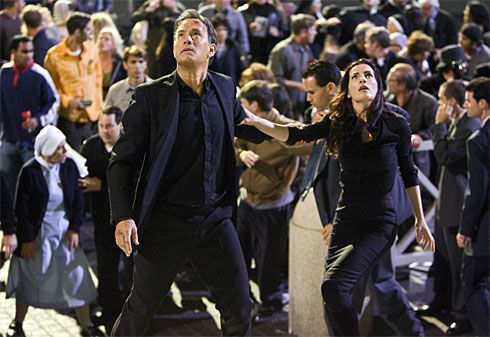It seems to me that the mini-furor (in comparison to the Da Vinci Code outcry) about the second Dan Brown film is entirely misplaced. Anyone who decries the film’s portrayal of the Catholic church hasn’t noticed that Howard’s depictions of violence are straight out of medieval representations of Christian Hell. There is more than enough fire and brimstone—not to mention unmentionable things done with rodents, brands, and weighted movers’ dollys—to go around. And for what? To spin out the story of a corrupt church embroiled in high-level conspiracy? When you put it this way, it’s not even a new story. Vatican conspiracies have been around as long as there have been Swiss Guards in Disneyland-style outfits. And so, at the film’s two-hour mark, faced with the imminent appearance of a scene of yet another symbolic branding, I had enough. Angels and Demons can claim the title of First Movie I Have Ever Walked Out Of.
Just before this breaking point in the movie, Howard and his screenwriters (if not Dan Brown himself) seemed to be saying something potentially interesting. In order to rescue the Vatican, Rome, the Church, and maybe even the world, the Camerlengo, a seemingly humble priest played with polished civility by Ewan MacGregor, takes a capsule of anti-matter up into the heavens in a helicopter (conveniently, in his youth, he trained as a helicopter pilot). Earlier in the film, someone mentions terrorists—of the suicide-bombing sort. When we see the heli-bound Camerlengo praying as the anti-matter’s timer counts down, we know we are about to witness a suicide bombing of a completely different sort. The explosion takes place, filling the night sky with lurid mauves, blues, and oranges—and quite neatly resembling the Sistine ceiling Howard has made sure to show us earlier. We are watching the self-immolation of one man so that he can save, not kill, thousands.

Or so we think. Because actually, the Camerlengo emerges from the still-throbbing explosion, dangling from a parachute. He is alive! If it is possible for a movie to jump the shark, Angels and Demons does it right here. Brown’s perverse instinct for the grotesque and the macabre—and his thoroughly deaf ear to the rhythms of narrative—compel him to keep the story going. Onwards, to another twist, to another branding, and to Tom Hanks’ rueful assertion that science and religion must coexist (I’m guessing on that last part. Did I get it right?).
As for Tom Hanks—at least we can say it’s nice to see him looking fit. Has he been working out? His character, Robert Langdon, is a fascinating creation in today’s world. A “symbologist”—I defy you to find a scholar anywhere who identifies him or herself this way—Langdon inhabits a world whose certainty hasn’t been seen since Sherlock Holmes could parse the life habits of an individual by looking at the polish of his shoes. Even a passing acquaintance of Photoshop tells you nothing is necessarily as it seems in the 21st century. And yet, for Langdon, everything is exactly as it seems. Statues’ arrows point in only one direction; maps can be read only one way; when carvings are considered sculpture, the assessment proves to be spot on. Even when, as in the case of the Bad Men of the church, no one is who he seems to be, everyone cooperates by being exactly his opposite. It’s amazing! Robert Langdon has escaped from Marvel Comics. The Symbologist! Surely the Riddler’s arch-enemy.
Angels and Demons is a movie full of wannabe symbols and real-life (or CGI) images of some of the world’s most famous art. But all that beauty, the movie is engulfed by images of detestable violence. You leave the cinema, alas, not thinking of the beauty of the Sistine Chapel (or even of Howard’s lovely nighttime explosion), but of scenes of cruelty that, like the movie itself, you’d prefer to forget.
Another review described Hanks' face as resembling an anxious potato throughout ... unfair? Or would you agree?
ReplyDeleteOh, he totally looks like a potato! It's a perfect image. (And, while we're at it, Kenneth Branagh in PBS' Wallander, looks, alas, like an old shoe.)
ReplyDelete